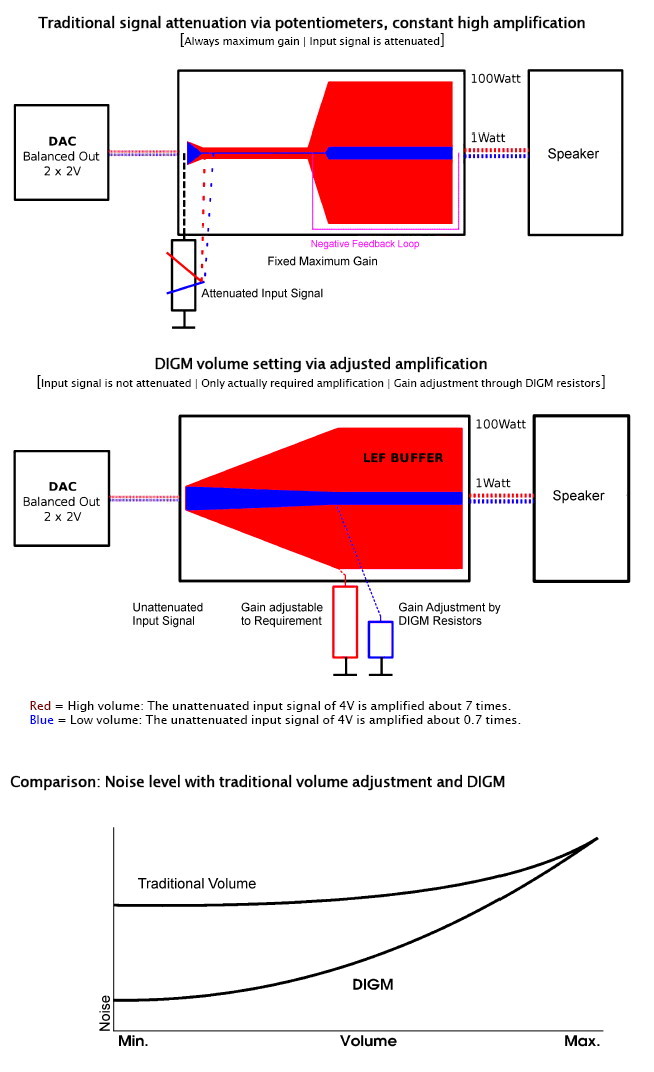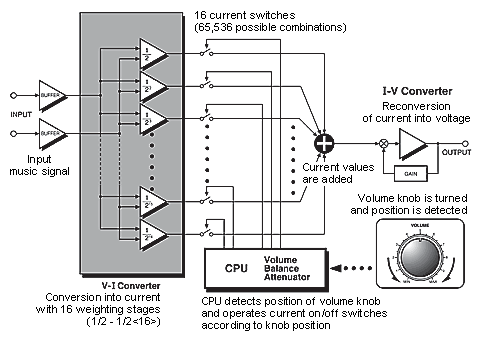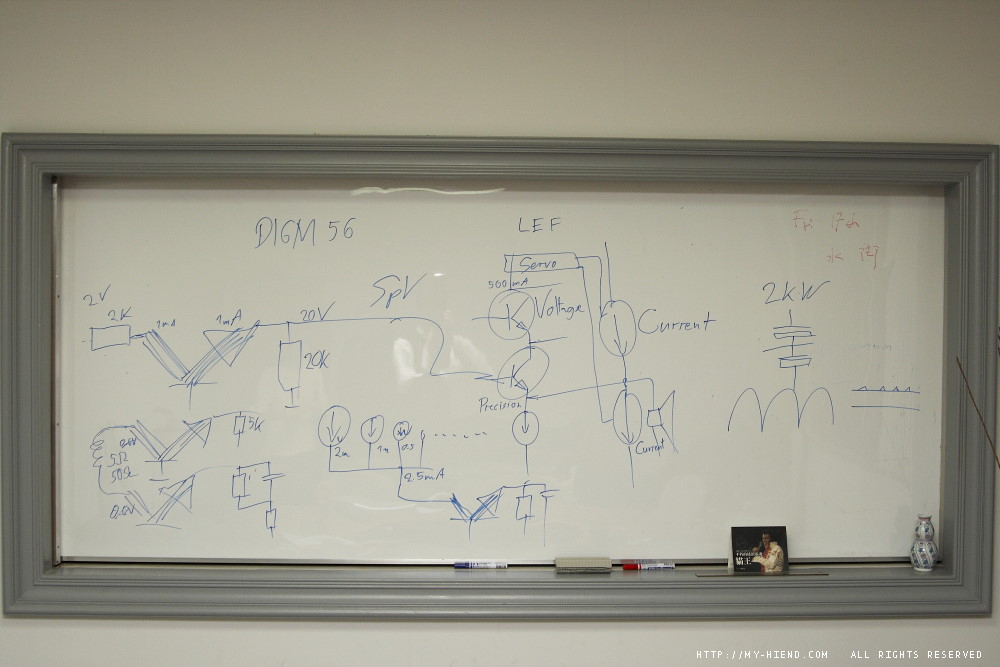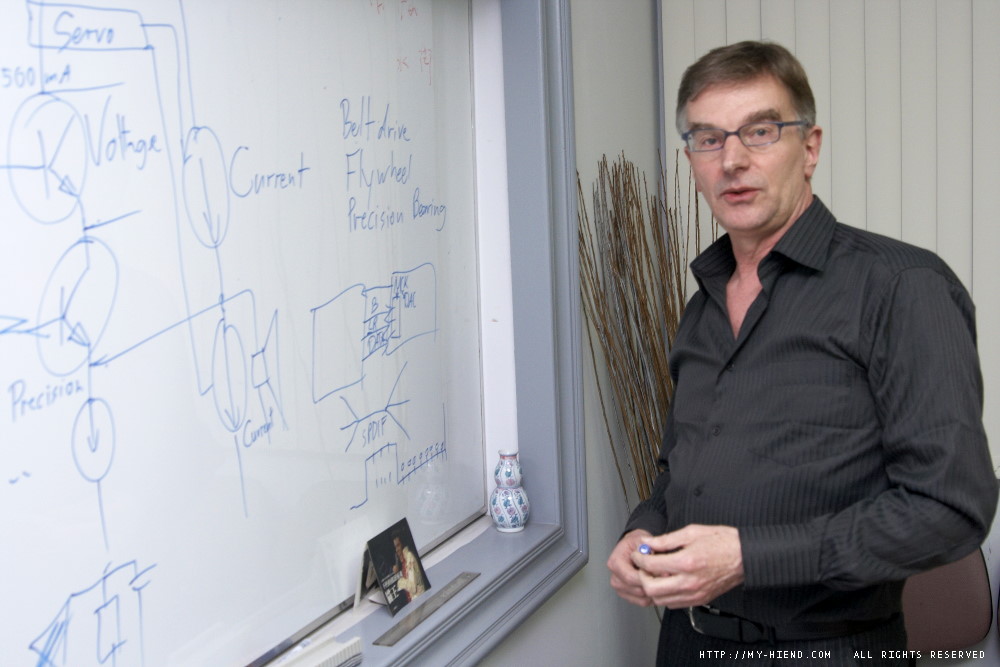
-

最後那級與Devialet的概念有些類似,都是以伺服電路參酌電壓放大級以校正電流放大級
http://www.google.com/patents?id=g6X...page&q&f=false
CI, current injection這詞有趣...
定名者,說不定是車迷...彷缸內直噴吧...

最下面這張圖的基本前提是擴大機內部總是會有某個程度的電源雜訊,
若輸入訊號一進擴大機就衰減,那麼訊號中的微弱變化量小於電源雜訊者,就會被雜訊蓋過去了...
這等效於放大雜訊的效應
因此才說,數位音量調整真的比擴大機內的VR衰減來的好嗎?難說...
-
The Following 2 Users Say Thank You to drunkenlife For This Useful Post:
-

這個幾個圖好像只對綜擴有意義。
如果前後級分開,除了唱頭放大之外,其他的訊號在進後級前不是都是衰減嗎?
-
-

沒有傳統前級的存在
Michael只提到input stage 與 output stage的處理方式
可看出目前B.M.C的產品沒有前級這一樣
http://www.bmc-audio.de/en/products.asp
也因為這樣的設計,他們的產品最好一套使用是最佳的
若有時間我會把錄音檔給放上來,大約40分鐘
其實我能理解的應該只有70~80%左右 (sweat)
前面的描述是我先就印象寫的
 作者: kevintran

這個幾個圖好像只對綜擴有意義。
如果前後級分開,除了唱頭放大之外,其他的訊號在進後級前不是都是衰減嗎?
-
-

可能想法想似,作法不一樣
B.M.C在Output Stage 採用電流與電壓分離的處理方式 (可參考第一張黑板的右方圖)
Accuphase的AAVA
http://www.accuphase.com/aava.html

-
-

YES
Michael 說一般的作法是在Input Stage會Copy訊號.......然後進行放大 (如10倍?)
 作者: 查德

Source訊號不變,只調整Gain去做音量調整,避免訊號失真的方法~
-
-

這不是全部 (有些講完已經擦掉)

MY-HIEND的朋友
你們有認真在聽嗎?
(站長我是聽完霧煞煞啦...)

-
-

[QUOTE=小葉;132373]這不是全部 (有些講完已經擦掉)
MY-HIEND的朋友
你們有認真在聽嗎?
(站長我是聽完霧煞煞啦...)
有聽沒有懂8)8)
-
-

 作者: kevintran

這個幾個圖好像只對綜擴有意義。
如果前後級分開,除了唱頭放大之外,其他的訊號在進後級前不是都是衰減嗎?
以DAC的高輸出而言,前後級加起來的gain實在太高了,沒啥必要吧...
 作者: 小葉

也因為這樣的設計,他們的產品最好一套使用是最佳的
這項該是指current injection,
若是DAC的輸出電流量不夠(例如我改的DAC),那就不佳
以一般的DAC而言,都會有個buffer級,應該沒問題,BMC文件也提到這點
 作者: 小葉

輸入級取的是電流,電壓放大級仍舊是固定gain(但有幾段可調),最後仍舊轉成電壓,以電壓驅動喇叭
這些與BMC不同
 作者: 小葉

YES
Michael 說一般的作法是在Input Stage會Copy訊號.......然後進行放大 (如10倍?)
一般輸入級是組差動電路,取的是電壓
在這之前是音量衰減可變電阻,
之後是固定電壓放大倍率的電路
BMC的架構與此完全不同,
Accuphase的架構只改變了輸入級
 作者: 小葉

輸入級以電流方式運作,一顆BJT就搞定了,
這架構若是搭上早期必須外掛I/V轉換的DAC IC,那,不就可以拿掉I/V轉換,更是簡潔...
突然看到設計者姓Conrad?與Conrad Johnson有關嗎?
-
The Following User Says Thank You to drunkenlife For This Useful Post:
-

Dear Leo,
Thanks a lot for your therad about BMC Audio! I can only read a little, and the google translation is not always correct... It is even harder to contribute something to your website, because my written Chinese is ZERO. But may be I can write to you by email, and step by step offer a little more information. As our technology is really new and unique, it is difficult to understand - even for people with a solid technical background. May be you can help me translating my comments to Chinese and publish them?
(以上翻譯略,就是Michael感謝MY-HIEND的報導,也希望我幫忙把他進一步解釋的部份翻成中文給大家,BMC的理論非常新與特別,就算是讀電子的可能也不太容易懂)
"Accuphase's AAVA circuit has nothing to do with our BMC design - much to complicated. AAVA has an input buffer, a V-I converter stage, a current addition and finally an I-V converter stage with a feedback loop and gain.
Accuphase AVVA的線路跟BMC不同,BMC複雜多了,AAVA有輸入緩衝,一個V-I轉換級,會增加電流,最終會有一個回授與增益的I-V轉換級。
To understand our approach it does not need to think that complicated.
瞭解BMC的方法不需要想得這麼複雜
CI input with DIGM volume control is a 1-stage amplification. The volume
control is just done with resistors (switched by transistors) at the output of this stage. After this gain adjustment there is no more voltage amplification. This means: The volume control happens at the voltage level of the speaker output.
使用DIGM音量控制的CI輸入是一級放大,音量控制是由輸出級的電阻(電晶體轉換)來處理,在這增益的調整後沒有任何電壓的放大,這意味著音量控制發生在喇叭輸出的電壓水平。
The only thing in common with the AAVA is: we have a potentiometer in the DAC1, a CPU reads out the position of the volume knob and translates it to a digital word, then this word is sent to the amplifier AMP S1 (or M1) by an optical connection. In the amplifier the digital word is used to activate some of the transistors of the DIGM to switch the required resistor (or combination of resistors).
與AAVA唯一相同的是,在B.M.C DAC1中,有個分壓計,CPU可以知道音量選鈕的位置將其變成數位語言,然後透過光纖將其發送到擴大機AMP S1 (或 M1)。在擴大機中,這些數位語言會啟動DIGM的電晶體來轉換成所需的電阻 (或將電阻組合)
It is a 1-stage design. The ouput of this stage is a current source. The gain is adjusted by the termination of this stage with a resistor, thus setting the I/V conversion."
這是一級的設計,在這級的輸出的來源是電流,增益是在這級最後由電阻來調整,就是I/V轉換
I hope this helps a little for a better understanding of DIGM.
I'll follow up with more explanations...
Best regards,
Michael
-
The Following 3 Users Say Thank You to Leo Yeh For This Useful Post:
-

 作者: 小葉

CI input with DIGM volume control is a 1-stage amplification. The volume
control is just done with resistors (switched by transistors) at the output of this stage. After this gain adjustment there is no more voltage amplification. This means: The volume control happens at the voltage level of the speaker output.
對照組是傳統擴大機的架構,
可變電阻衰減->差動輸入級->偏壓級->功率晶體驅動級->輸出級
 作者: 小葉

The only thing in common with the AAVA is: we have a potentiometer in the DAC1, a CPU reads out the position of the volume knob and translates it to a digital word, then this word is sent to the amplifier AMP S1 (or M1) by an optical connection. In the amplifier the digital word is used to activate some of the transistors of the DIGM to switch the required resistor (or combination of resistors).
這段很有意思...
這點出了BMC DAC的音量控制能夠直接調整BMC二款後級的gain,而非在數位端調整,也不是在DAC的類比輸出處衰減(這等於傳統前級擴大機的手法)
因此若使用BMC DAC + S1或M1,無需前級擴大機
 作者: 小葉

It is a 1-stage design. The ouput of this stage is a current source. The gain is adjusted by the termination of this stage with a resistor, thus setting the I/V conversion."
傳統擴大機的架構則是五級,功率晶體驅動級->輸出級這段是電流,其他都是電壓
gain固定,音量控制是以衰減輸入訊號方式處理
-
 發文規則
發文規則
- 您不可以發表新主題
- 您不可以發表回覆
- 您不可以上傳附件
- 您不可以編輯自己的文章
-
討論區規則
|













